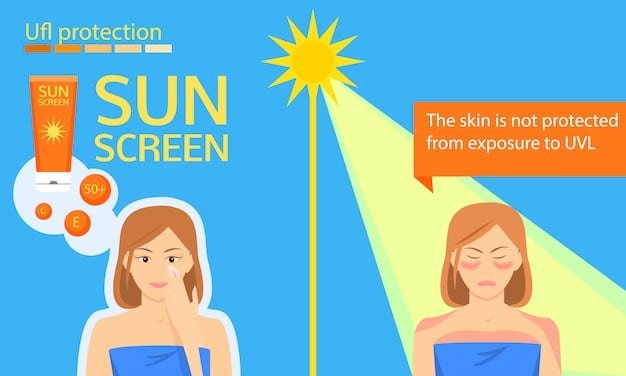Sunscreen in 2025: Are You Really Protected? New US Standards Explained

Is Your Sunscreen Actually Protecting You? New 2025 US Standards Explained examines how upcoming regulations aim to enhance the effectiveness and transparency of sunscreen products in the United States, ensuring consumers are better shielded from harmful UV rays.
Are you confident that your sunscreen is providing the protection it promises? With the introduction of new U.S. standards in 2025, the landscape of sun protection is set to change. Let’s explore what these updates mean for you and how they will enhance your skin’s defense against the sun.
Understanding the Current Sunscreen Landscape
The world of sunscreen can often seem like a complex mix of numbers, acronyms, and promises. Before diving into the specifics of the new 2025 standards, it’s essential to grasp the current state of sunscreen regulation and labeling in the United States.
Currently, sunscreens are regulated by the Food and Drug Administration (FDA) as over-the-counter (OTC) drugs. This classification means sunscreens must meet specific requirements for safety and efficacy. However, the existing regulations, some of which date back decades, have struggled to keep pace with scientific advancements and consumer demands.
Decoding SPF and Broad Spectrum Protection
SPF, or Sun Protection Factor, is a familiar term, but what does it really mean? SPF measures a sunscreen’s ability to block UVB rays, the primary cause of sunburn. A higher SPF indicates more protection, but it’s not linear. For instance, SPF 30 blocks about 97% of UVB rays, while SPF 50 blocks about 98%.
Broad spectrum protection is equally vital. It means the sunscreen protects against both UVA and UVB rays. UVA rays penetrate deeper into the skin and contribute to premature aging and skin cancer. Sunscreens labeled “broad spectrum” have passed specific FDA tests to ensure they provide this comprehensive defense.
- SPF Numbers: Higher SPF provides greater UVB protection but with diminishing returns.
- Broad Spectrum: Ensures protection against both UVA and UVB rays.
- FDA Regulations: Sunscreens are regulated as over-the-counter drugs.
In summary, understanding the current sunscreen landscape requires decoding SPF values and ensuring the product offers broad spectrum protection. While existing regulations have provided a baseline, upcoming changes aim to raise the bar for efficacy and transparency.
Why New Standards Are Needed
The push for updated sunscreen standards in the U.S. isn’t arbitrary. It stems from a combination of scientific advancements, growing concerns about ingredient safety, and the need to align with international standards. This section will delve into the key reasons driving the call for these changes.
One of the primary drivers is the evolving understanding of sunscreen ingredients and their potential impact on human health and the environment. Some chemicals commonly found in sunscreens, such as oxybenzone and octinoxate, have raised concerns due to their potential hormonal effects and harm to coral reefs.

Ingredient Safety Concerns
Several studies have explored the absorption of sunscreen chemicals into the bloodstream. While the FDA has stated that this absorption doesn’t necessarily indicate harm, it has called for further research to assess the long-term effects. This cautious approach underscores the need for more stringent safety evaluations.
Moreover, the rising incidence of skin cancer globally emphasizes the necessity of more effective sun protection measures. The current standards, some of which were established decades ago, need to be updated to reflect the latest scientific knowledge and ensure consumers have access to products that provide reliable protection.
- Evolving Science: New research highlights potential risks associated with certain sunscreen ingredients.
- Health Concerns: Rising skin cancer rates necessitate more effective sun protection.
- Environmental Impact: Some sunscreen chemicals harm coral reefs, prompting a need for safer alternatives.
In a nutshell, the impetus for new sunscreen standards arises from the need to address concerns regarding ingredient safety, enhance protection against rising skin cancer rates, and minimize environmental impact. These factors collectively advocate for an overhaul of existing regulations.
Key Changes in the 2025 Standards
The forthcoming 2025 sunscreen standards promise significant improvements in how sunscreens are regulated, tested, and labeled in the United States. This section outlines the most notable changes consumers can anticipate.
One of the core updates involves stricter testing requirements for broad spectrum protection. The new standards aim to ensure that sunscreens provide adequate defense against UVA rays, which are just as damaging as UVB rays but often overlooked. Manufacturers will need to meet more rigorous criteria to earn the “broad spectrum” label.
Enhanced Broad Spectrum Testing
In addition to broad spectrum testing, the FDA is also expected to implement changes to the maximum SPF value that can be labeled on sunscreen products. Currently, sunscreens can be labeled with SPF values as high as 100+, but there is limited evidence that these high-SPF products offer significantly better protection than those with SPF 50 or 60.
Furthermore, the new standards are likely to address concerns related to water resistance claims. The FDA is expected to introduce more standardized and stringent testing protocols to ensure that sunscreens maintain their effectiveness after exposure to water or sweat.
- Stricter Testing: More rigorous tests for broad spectrum protection to ensure UVA defense.
- SPF Caps: Potential limits on maximum SPF values to prevent misleading claims.
- Water Resistance: Standardized testing for water resistance to ensure effectiveness after water exposure.
In summary, the 2025 sunscreen standards are set to bring about crucial changes in testing requirements, SPF labeling, and water resistance claims. These updates collectively aim to provide consumers with more reliable and transparent information about the sunscreens they use.
Impact on Sunscreen Manufacturers
The introduction of new sunscreen standards will undoubtedly have a significant impact on manufacturers. Companies will need to adapt their formulations, testing procedures, and labeling practices to comply with the updated regulations. This section explores the challenges and adjustments sunscreen manufacturers may face.
One of the most immediate challenges will be reformulating products to meet the stricter broad spectrum protection requirements. This may involve incorporating new ingredients or adjusting the concentrations of existing ones. Manufacturers will also need to invest in updated testing equipment and protocols to ensure their products meet the new standards.
Reformulation and Testing Challenges
In addition to reformulation and testing, sunscreen manufacturers will also need to revise their labeling to comply with the new regulations. This may involve changes to SPF values, water resistance claims, and ingredient lists. Clear and accurate labeling will be essential to maintain consumer trust and avoid potential legal issues.
Furthermore, the new standards may prompt manufacturers to explore alternative sunscreen ingredients that are both effective and environmentally friendly. This could lead to increased research and development efforts focused on mineral-based sunscreens and other innovative formulations.

- Reformulation: Adapting product formulas to meet stricter broad spectrum requirements.
- Testing Investment: Investing in new equipment and protocols for updated testing procedures.
- Labeling Revisions: Updating labels for accurate SPF values, water resistance claims, and ingredient lists.
Ultimately, the impact on sunscreen manufacturers will be multifaceted, requiring them to adapt their products, processes, and communication strategies to align with the new standards. While this may present challenges, it also offers opportunities for innovation and enhanced consumer trust.
How Consumers Will Benefit
The updated sunscreen standards are designed to bring numerous benefits to consumers. From clearer labeling to more effective protection, these changes aim to empower individuals to make informed decisions about their sun care.
One of the most significant advantages for consumers will be the increased reliability of sunscreen claims. The stricter testing requirements for broad spectrum protection and water resistance will ensure that products deliver the protection they promise. This increased transparency will help consumers choose sunscreens that truly meet their needs.
Increased Transparency and Reliability
In addition to enhanced reliability, the new standards may also lead to a wider range of sunscreen options. As manufacturers explore alternative ingredients and formulations, consumers may have access to products that are not only effective but also more environmentally friendly and better suited to their individual skin types.
Moreover, the potential capping of SPF values could simplify the selection process for consumers. Rather than being swayed by misleadingly high SPF numbers, individuals can focus on choosing sunscreens that offer adequate broad spectrum protection and water resistance.
- Reliable Claims: Stricter testing ensures sunscreens deliver the promised protection.
- Wider Range of Options: Exploration of alternative ingredients leads to more diverse products.
- Simplified Selection: Focus on broad spectrum protection rather than misleadingly high SPF values.
In conclusion, consumers stand to benefit significantly from the updated sunscreen standards through increased transparency, enhanced reliability, and a broader selection of effective and environmentally conscious sun care options.
Preparing for the 2025 Transition
As the 2025 sunscreen standards approach, it’s essential for both manufacturers and consumers to prepare for the transition. This section offers practical tips to ensure a smooth shift to the new regulations.
For manufacturers, proactive steps include staying informed about the evolving regulatory landscape, investing in necessary equipment and training, and engaging in research and development to explore innovative formulations. Collaboration with industry experts and regulatory bodies can also facilitate a seamless transition.
Practical Tips for Manufacturers and Consumers
Consumers, too, can take steps to prepare for the changes. This includes educating themselves about the new standards, reading sunscreen labels carefully, and seeking recommendations from dermatologists and other trusted sources. Staying informed about product recalls and safety alerts is also crucial.
Additionally, consumers should be prepared to adjust their sunscreen purchasing habits. This may involve trying new brands or formulations as manufacturers update their products to meet the new standards. Being open to mineral-based sunscreens and other alternative options can also broaden one’s choices.
- Stay Informed: Keep up-to-date with the latest news and guidelines regarding the new standards.
- Read Labels Carefully: Pay attention to SPF values, broad spectrum claims, and ingredient lists.
- Seek Recommendations: Consult with dermatologists and other experts for personalized advice.
Overall, preparing for the 2025 transition involves proactive measures from both manufacturers and consumers. By staying informed, adapting to changes, and prioritizing safety and effectiveness, everyone can benefit from the updated sunscreen standards.
| Key Point | Brief Description |
|---|---|
| ☀️ Broad Spectrum | Ensures protection against both UVA and UVB rays with stricter testing. |
| 🧪 Ingredient Safety | Addresses concerns about potentially harmful sunscreen chemicals. |
| 💧 Water Resistance | Standardized testing to guarantee effectiveness after water exposure. |
| ✅ Reliable Claims | Ensures sunscreens deliver the protection they promise through rigorous testing. |
FAQ Section
▼
Broad spectrum means the sunscreen protects against both UVA and UVB rays. UVA rays contribute to aging, while UVB rays cause sunburn. Effective sunscreens should guard against both to prevent skin damage.
▼
New standards address concerns about ingredient safety, rising skin cancer rates, and the need for more effective sun protection. They also aim to align with international standards and improve product reliability.
▼
The 2025 standards will introduce stricter testing requirements for broad spectrum protection and water resistance. This ensures that sunscreens provide the promised level of protection, even after exposure to water or sweat.
▼
Look for sunscreens with broad spectrum protection, a suitable SPF (30 or higher is generally recommended), and water resistance. Check the ingredient list for any chemicals you may want to avoid based on personal preferences.
▼
Stay informed about the new standards, read sunscreen labels carefully, and consult with dermatologists or other trusted sources for personalized recommendations. Be open to trying new brands and formulations as they emerge.
Conclusion
As we approach 2025, the new sunscreen standards promise a more reliable and transparent sun protection landscape. By understanding these changes and taking proactive steps, both manufacturers and consumers can ensure better skin health and safety.





